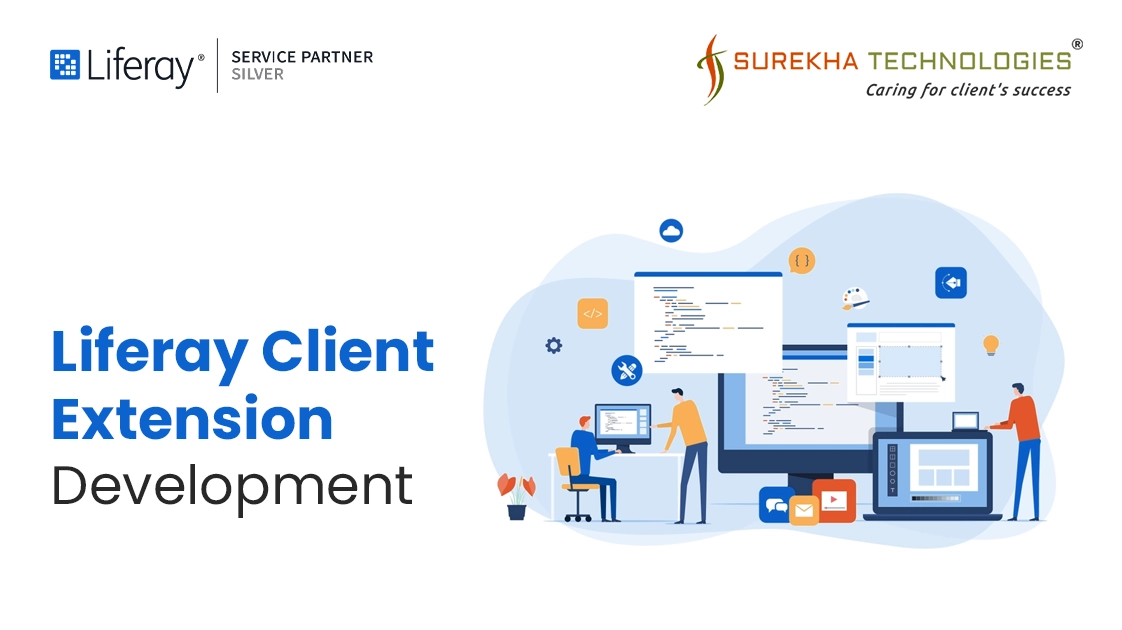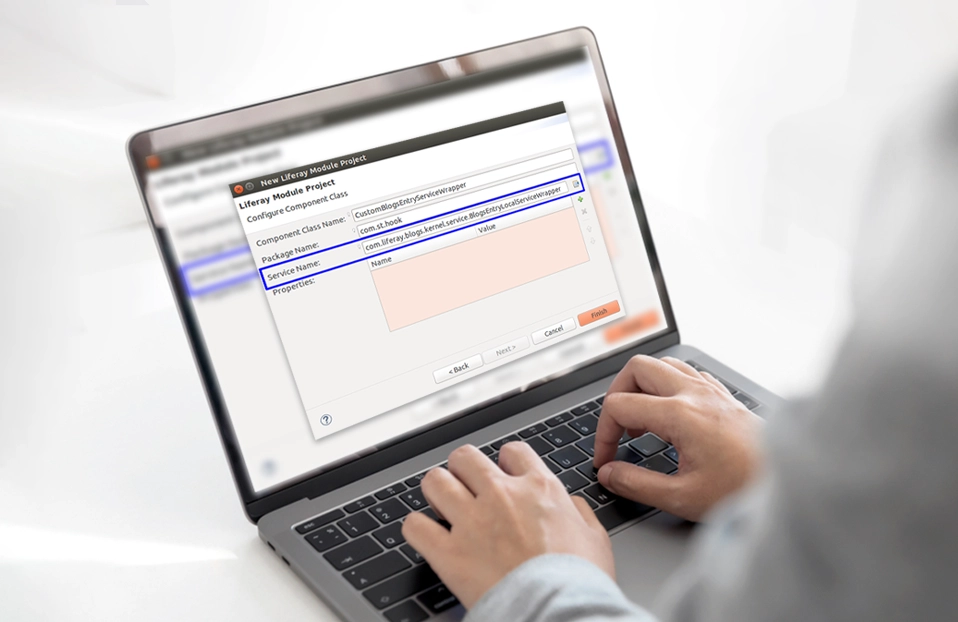In this blog, we will learn how to create a custom element type client extension for a React application from scratch, and how to build and deploy it using the Gradle build tool. As a bonus, we will also create a batch type client extension to automate the process of importing objects into the Liferay server.
By the end of this blog, you will have a solid understanding of how to create these types of client extension, build and deploy them using Gradle.
Client extensions enable developers to create separate components that extend Liferay's functionality without modifying Liferay’s core codebase, ensuring maintainability and ease of upgrades. These components can be built with modern web technologies such as React, Angular, and other modern JavaScript frameworks.
CustomElement extensions can be created using modern web frameworks like React, Vue, or plain JavaScript, and deployed as standalone components.
To import or export data in Liferay, Batch client extensions are used. Batch type client extensions work with Liferay’s batch engine framework to provide data entry to your Liferay server instance.
{
"configuration": {
"className": "com.liferay.object.admin.rest.dto.v1_0.ObjectDefinition",
"parameters": {
"containsHeaders": "true",
"createStrategy": "UPSERT",
"importStrategy": "ON_ERROR_FAIL",
"updateStrategy": "UPDATE"
},
"taskItemDelegateName": "DEFAULT"
},
"items": [
{"enableComments":false,"objectRelationships":[],"enableCategorization":true,"accountEntryRestrictedObjectFieldName":"","objectActions":[],"accountEntryRestricted":false,"externalReferenceCode":"additional_payment_detail","objectFields":[{"indexed":false,"objectFieldSettings":[],"readOnly":"true","DBType":"String","label":{"en_US":"Author"},"type":"String","required":false,"externalReferenceCode":"be0b3aa2-a3a8-df0e-28ba-d316719fae39","indexedAsKeyword":false,"system":true,"indexedLanguageId":"","name":"creator","state":false,"businessType":"Text","readOnlyConditionExpression":""},{"indexed":false,"objectFieldSettings":[],"readOnly":"true","DBType":"Date","label":{"en_US":"Create Date"},"type":"Date","required":false,"externalReferenceCode":"2f4a60a9-c79f-0a24-667c-b1a11856aadb","indexedAsKeyword":false,"system":true,"indexedLanguageId":"","name":"createDate","state":false,"businessType":"Date","readOnlyConditionExpression":""},{"indexed":false,"objectFieldSettings":[],"readOnly":"false","DBType":"String","label":{"en_US":"External Reference Code"},"type":"String","required":false,"externalReferenceCode":"b1684cfc-0fa0-2ea5-dc9e-c55fab1c83d1","indexedAsKeyword":false,"system":true,"indexedLanguageId":"","name":"externalReferenceCode","state":false,"businessType":"Text","readOnlyConditionExpression":""},{"indexed":true,"objectFieldSettings":[],"readOnly":"true","DBType":"Long","label":{"en_US":"ID"},"type":"Long","required":false,"externalReferenceCode":"82bad67a-f874-8519-0d96-cf0bafb6a692","indexedAsKeyword":true,"system":true,"indexedLanguageId":"","name":"id","state":false,"businessType":"LongInteger","readOnlyConditionExpression":""},{"indexed":false,"objectFieldSettings":[],"readOnly":"true","DBType":"Date","label":{"en_US":"Modified Date"},"type":"Date","required":false,"externalReferenceCode":"69d236c8-4076-13f4-9b51-d2034dfcedd4","indexedAsKeyword":false,"system":true,"indexedLanguageId":"","name":"modifiedDate","state":false,"businessType":"Date","readOnlyConditionExpression":""},{"indexed":false,"objectFieldSettings":[],"readOnly":"true","DBType":"String","label":{"en_US":"Status"},"type":"String","required":false,"externalReferenceCode":"ef9d806b-305d-b21b-dc58-b57276d31222","indexedAsKeyword":false,"system":true,"indexedLanguageId":"","name":"status","state":false,"businessType":"Text","readOnlyConditionExpression":""},{"indexed":true,"objectFieldSettings":[],"readOnly":"false","DBType":"String","label":{"en_US":"Udf1"},"type":"String","required":false,"externalReferenceCode":"d134a1e6-42ac-bbf5-455e-be2fd9c096ec","indexedAsKeyword":false,"system":false,"indexedLanguageId":"en_US","name":"udf1","state":false,"businessType":"Text","readOnlyConditionExpression":""},{"indexed":true,"objectFieldSettings":[],"readOnly":"false","DBType":"String","label":{"en_US":"Udf2"},"type":"String","required":false,"externalReferenceCode":"5f627b10-48f0-cd8d-685f-205e32bd51ea","indexedAsKeyword":false,"system":false,"indexedLanguageId":"en_US","name":"udf2","state":false,"businessType":"Text","readOnlyConditionExpression":""},{"indexed":true,"objectFieldSettings":[],"readOnly":"false","DBType":"String","label":{"en_US":"Udf3"},"type":"String","required":false,"externalReferenceCode":"268e76af-200b-2e10-136f-e5e90c56bb1a","indexedAsKeyword":false,"system":false,"indexedLanguageId":"en_US","name":"udf3","state":false,"businessType":"Text","readOnlyConditionExpression":""},{"indexed":true,"objectFieldSettings":[],"readOnly":"false","DBType":"String","label":{"en_US":"Udf4"},"type":"String","required":false,"externalReferenceCode":"13e9f565-9cfb-7603-763f-db84db99195a","indexedAsKeyword":false,"system":false,"indexedLanguageId":"en_US","name":"udf4","state":false,"businessType":"Text","readOnlyConditionExpression":""},{"indexed":true,"objectFieldSettings":[],"readOnly":"false","DBType":"String","label":{"en_US":"Udf5"},"type":"String","required":false,"externalReferenceCode":"bba7db4f-75e5-9786-3e76-535095f94b28","indexedAsKeyword":false,"system":false,"indexedLanguageId":"en_US","name":"udf5","state":false,"businessType":"Text","readOnlyConditionExpression":""},{"indexed":true,"objectFieldSettings":[],"readOnly":"false","DBType":"String","label":{"en_US":"Udf6"},"type":"String","required":false,"externalReferenceCode":"46cbf6ea-5b48-2403-96ea-d71175962e47","indexedAsKeyword":false,"system":false,"indexedLanguageId":"en_US","name":"udf6","state":false,"businessType":"Text","readOnlyConditionExpression":""},{"indexed":true,"objectFieldSettings":[],"readOnly":"false","DBType":"String","label":{"en_US":"Udf7"},"type":"String","required":false,"externalReferenceCode":"46d3eb83-b3ad-2dd6-b15c-e5a0cf778569","indexedAsKeyword":false,"system":false,"indexedLanguageId":"en_US","name":"udf7","state":false,"businessType":"Text","readOnlyConditionExpression":""},{"indexed":true,"objectFieldSettings":[],"readOnly":"false","DBType":"String","label":{"en_US":"Udf8"},"type":"String","required":false,"externalReferenceCode":"66acbf75-484e-49ce-940f-e337073826fa","indexedAsKeyword":false,"system":false,"indexedLanguageId":"en_US","name":"udf8","state":false,"businessType":"Text","readOnlyConditionExpression":""},{"indexed":true,"objectFieldSettings":[],"readOnly":"false","DBType":"String","label":{"en_US":"udf9"},"type":"String","required":false,"externalReferenceCode":"e4a8ce65-13a7-77e8-cd35-4c17b2949944","indexedAsKeyword":false,"system":false,"indexedLanguageId":"en_US","name":"udf9","state":false,"businessType":"Text","readOnlyConditionExpression":""},{"indexed":true,"objectFieldSettings":[],"readOnly":"false","DBType":"String","label":{"en_US":"Udf10"},"type":"String","required":false,"externalReferenceCode":"e2473408-afcf-ca71-90be-756849722e98","indexedAsKeyword":false,"system":false,"indexedLanguageId":"en_US","name":"udf10","state":false,"businessType":"Text","readOnlyConditionExpression":""},{"indexed":true,"objectFieldSettings":[],"readOnly":"false","DBType":"String","label":{"en_US":"Error"},"type":"String","required":false,"externalReferenceCode":"84f5bd5a-26ba-5bad-7c8e-ee03e5840679","indexedAsKeyword":false,"system":false,"indexedLanguageId":"en_US","name":"error","state":false,"businessType":"Text","readOnlyConditionExpression":""},{"indexed":true,"objectFieldSettings":[],"readOnly":"false","DBType":"String","label":{"en_US":"ErrorText"},"type":"String","required":false,"externalReferenceCode":"2340c932-8d6f-c872-8c6e-4d523249dc32","indexedAsKeyword":false,"system":false,"indexedLanguageId":"en_US","name":"errorText","state":false,"businessType":"Text","readOnlyConditionExpression":""},{"indexed":true,"objectFieldSettings":[],"readOnly":"false","DBType":"String","label":{"en_US":"correlationId"},"type":"String","required":false,"externalReferenceCode":"26cb59cd-60cd-0d3a-6db2-3aa761dc4715","indexedAsKeyword":false,"system":false,"indexedLanguageId":"en_US","name":"correlationId","state":false,"businessType":"Text","readOnlyConditionExpression":""},{"indexed":true,"objectFieldSettings":[],"readOnly":"false","DBType":"String","label":{"en_US":"TransactionStatus"},"type":"String","required":false,"externalReferenceCode":"3a292192-c14b-8762-c270-6d9841e1fc06","indexedAsKeyword":false,"system":false,"indexedLanguageId":"en_US","name":"transactionStatus","state":false,"businessType":"Text","readOnlyConditionExpression":""},{"indexed":true,"objectFieldSettings":[],"readOnly":"false","DBType":"Long","label":{"en_US":"Payment Detail Id"},"type":"Long","required":false,"externalReferenceCode":"756dd90c-60a2-00d4-099b-c4855ab9272d","indexedAsKeyword":false,"system":false,"indexedLanguageId":"","name":"paymentDetailId","state":false,"businessType":"LongInteger","readOnlyConditionExpression":""},{"indexed":true,"objectFieldSettings":[],"readOnly":"false","DBType":"String","label":{"en_US":"TrackId"},"type":"String","required":false,"externalReferenceCode":"845a489b-5836-b388-cea6-122804f9a6f6","indexedAsKeyword":false,"system":false,"indexedLanguageId":"en_US","name":"trackId","state":false,"businessType":"Text","readOnlyConditionExpression":""}],"restContextPath":"/o/c/additionalpaymentdetails","scope":"site","portlet":true,"parameterRequired":false,"enableObjectEntryHistory":false,"titleObjectFieldName":"id","objectValidationRules":[],"active":true,"defaultLanguageId":"en_US","label":{"en_US":"AdditionalPaymentDetail"},"panelCategoryKey":"site_administration.content","pluralLabel":{"en_US":"AdditionalPaymentDetails"},"objectLayouts":[],"system":false,"objectViews":[],"name":"AdditionalPaymentDetail","actions":{"permissions":{},"get":{},"update":{},"delete":{}},"status":{"label_i18n":"Approved","code":0,"label":"approved"}}
]
}
In this blog, we explored how to create and deploy two distinct types of Liferay client extensions: Custom Elements and Batch Types. Custom Elements utilize modern web frameworks like React to extend Liferay’s user interface, allowing for dynamic, reusable front-end components that can be seamlessly integrated. On the other hand, Batch Types are designed to automate backend operations such as data export/import, leveraging Liferay's batch engine for streamlined data management. While each serves a different function, both types can be built and deployed efficiently by configuring the client-extension.yaml file and running simple Gradle commands. Together, they offer a flexible, scalable approach to enhancing Liferay’s capabilities without modifying its core architecture.
Let's connect to discuss how we can help to unlock the full potential of your digital platform with Liferay development services! For free consultation contact us today!




